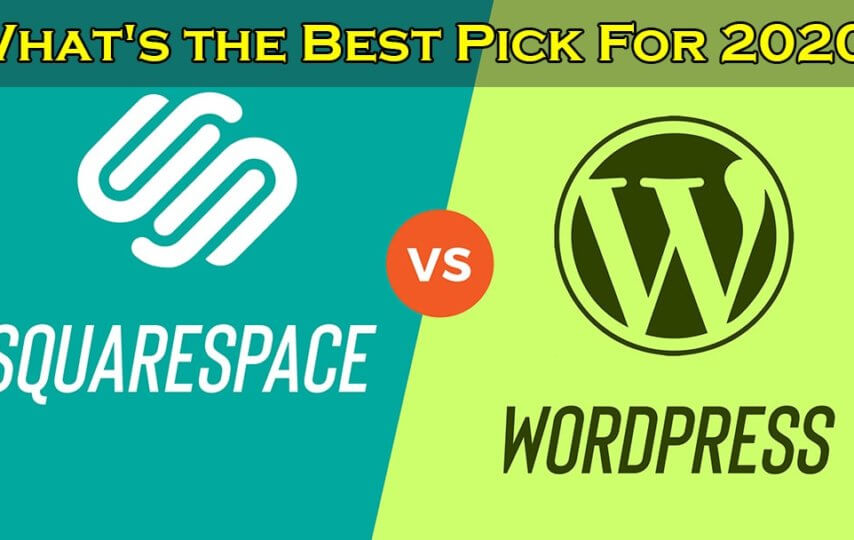In this correlation between Squarespace and WordPress, we take a close look at two of the world’s leading web-building platforms.
We give an overview of what these two tools do, analyze their top features, and explain why you can choose one over the other for a web design company.
At the end of this article, you will have a clear perspective on these two platforms.
But first a short intro to these platforms,
Squarespace
There are approximately 2 million websites created on Squarespace that was launched in 2004.
You pay a monthly fee to use it, but everything you need to assemble and maintain is given as part of it: templates, hosting, a domain, web-based business, support, and a content management framework based on your request.
Recently, an email marketing tool, ‘Squarespace Email Campaigns’ has been added to the functionality, which underscores this all-in-one approach.
WordPress
WordPress is a free site publishing tool for creating great websites or blogs. It is an effective open source content management tool that was created in PHP and can be easily installed and customized to your needs.
Hosted WordPress is, like Squarespace, a product designed to help (SaaS) tools. As with Squarespace, you pay a monthly fee and you get access to a wide range of highlights that enable you to create and maintain a website.
It is marginally less of an ‘across the board’ arrangement than Squarespace, as it may be, as customers have to use outsider tools such as Ecwid or Shopify to include highlights from the internet business, and the use of the most attractive topics comes with an extra charge.
On the other hand, it is a more adaptable tool than Squarespace because you can coordinate it with more applications, or buy more formats for it.
Cost comparison
WordPress itself is free. You are allowed to download, use, and extend WordPress. It is open source programming with a GPL authorization that gives you all the opportunity and control.
In order to assemble your website with WordPress, you should register a domain and set up a web hosting account.
Depending on your requirements, you can choose a common hosting plan, VPS hosting, or even WordPress hosting. Mutual hosting plans work for a most little near residential and business sites.
The cost of web hosting and domain names will vary depending on which hosting provider you work with. You are responsible for how much assets you need for your website and how much you pay for it.
With over 6800 + free formats and 54,000 + free modules, you can run your website for less than $2.75 per month that includes your domain name and hosting.
One reason for the popularity of WordPress is that the overall cost of building your site with WordPress is low.
Apart from that, you can change your hosting plan depending on how your website develops, which means that you will only receive compensation for the assets you actually use.
The basic plan for Squarespace starts at $12 per month, which is calculated annually, or $16 per month. This is slightly more than a common hosting plan for WordPress.
However, unlike an ordinary WordPress hosting plan, this basic plan accompanies extremely limited highlights. You can just add two supporters to your site, and you can’t sell any items.
Although you can start an online store with WordPress for not as much as that.
Squarespace’s business plan starts at $18 per month or $26 per month. It includes e-commerce support but charges a 3% conversion fee. The business plan includes unlimited donors, pages, and extra-powered highlights.
They also have their own designs for online stores, which start at $26 per month with no extra conversion costs.
Templates Designs
WordPress provides access to a variety of free and paid site formats. These layouts are deeply customizable and allow you to transfer your own logo, shades, your own images, and the sky is the limit from there.
Numerous WordPress themes accompany various format choices, intuitive page developers, sliders, photo exhibitions, and lots of different highlights.
Regardless of the type of website you are building, you will discover many professionally structured formats for the activity.
Many beginners find this variety of decisions a little overwhelming.
Squarespace offers instant website layouts that are perfectly sorted into different classifications. There are themes for all known website classifications, with competent designs that look good on all devices.
In any case, this is an important region where Squarespace is really falling behind. There’s a limited number of pre-made formats, and your plan alternatives are additionally limited to the array of highlights accessible in the Squarespace Customizer.
Topics accompany a given number of format choices for each layout. You can even now do essential colors, text styles, site-logos, and other things but these formats are not as customizable as WordPress themes.
Extensions
The real power of WordPress comes from its huge environment of plugins. These plugins resemble applications for your WordPress site that you can introduce to add new highlights or change the default behavior of your site.
There are currently more than 54,000 free WordPress plugins in the WordPress.org plugin registry alone. In addition, there are a large number of premium WordPress plugins that are accessible from external sites.
At the chance that you can think about a component, there is a good possibility that you effectively discover a WordPress plugin that does it.
WordPress plugins are so strong that a considerable amount of them are indisputable platforms with their own additional plugins and a thriving network around them.
At this point, you have certain plugins to make Internet business websites, establish enrollment networks, sell online courses, and the sky is the limit from there.
Since WordPress is the most popular web designer, most external administrations and devices have their own WordPress plugins that integrate their administrations into a WordPress site.
All of the best email marketing services, SEO tools, live chat software, and lead generation tools provide consistent compatibility with WordPress.
Squarespace does not exist in WordPress in terms of extensibility and mixes.
It is conceivable to add outsider mixes and customizations that are not yet similar to WordPress. Squarespace does not have incredible APIs that engineers can extend.
There are, however, some official reconciliations for outsiders, but even these are limited, and not every single mainstream government is sustained.
For e-commerce, you can use your implicit platform, but not expand it in any way.
Squarespace is short on the usefulness of allowing custom websites that you need for your online business idea.
In summary,
WordPress is by far an unrivaled platform as Squarespace in terms of building a website. Here is a quick breakdown of the pros and cons of the two platforms.
WordPress
Pros:
Easy to use with little expectation to learn and
adapt to any type of website
A monstrous selection of themes and plugins
Really groundbreaking eCommerce platform
Can be started with little to no effort
Cons:
You need to install updates and backups
You need to measure your hosting manually by updating your hosting as a business development
Squarespace
Pros:
Easier for little Sites
Neat user experience
Bother free site arrangement
Cons:
Costs higher than Shared Hosting Site
Restricted planning decisions
Limited arrangement of highlights
Restrictions put you in developing your business
Summary
The ability to develop your website will be significant for all companies. WordPress offers you this opportunity at a much lower cost than any other platform.













